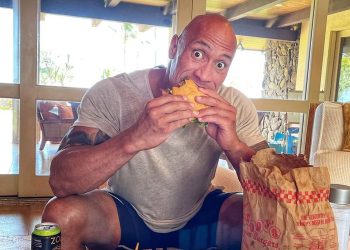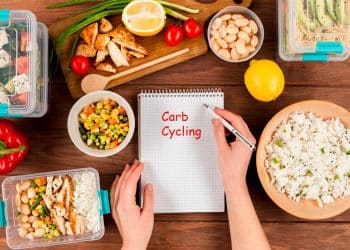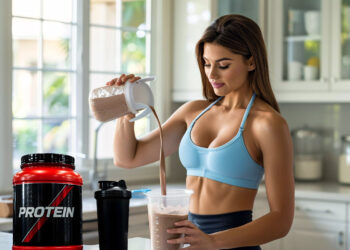Desire a strong, chiseled midsection? Crave abs that resemble an old-fashioned washboard? This guide is your blueprint for success!
A large and growing percentage of the world’s population is overweight and getting fatter. As such, a lot of abs training advice is designed to help shrink your waistline and give you a slimmer midsection.
That’s fine if you are overly fat – you NEED to shed those unwanted pounds for your health and longevity.
But what if you are a more slender person who wants to develop thicker, more muscular abs? Should you train the same way as someone who’s overweight?
Absolutely not!
Building deeply etched abs you can almost see from space necessitates a distinct workout and diet strategy. Training like someone focused on weight loss could hinder your progress.
Level Up Your Fitness: Join our 💪 strong community in Fitness Volt Newsletter. Get daily inspiration, expert-backed workouts, nutrition tips, the latest in strength sports, and the support you need to reach your goals. Subscribe for free!
This article serves as your roadmap to constructing thick, powerful abs.
Avoid These Mistakes for Bigger Abs
Before delving into the steps for building impressive abs, let’s address the pitfalls to sidestep. It’s surprisingly easy to impede your progress by committing avoidable errors.
Ensure you avoid these common mistakes:
1. Excessive Abs Training
Muscles require recovery periods to grow. Training your abs excessively limits their recovery time, potentially hindering progress. Limit your abs workouts to 2-3 sessions per week on non-consecutive days, allowing adequate recovery time between sessions.
Need a structured plan? We’ve got you covered! A tailored workout awaits you later in this article.
2. Solely Relying on High Reps
While high-rep abs training has its merits, consistent reliance on it can be counterproductive. Performing high-rep sets for every exercise in your routine overworks the same muscle fibers.
Incorporate a variety of rep ranges, including low, medium, and high reps, to engage a broader spectrum of muscle fibers and maximize your training efficiency.
3. Neglecting Full-Body Strength
Even the most targeted abs program needs the support of full-body training for optimal results. Prioritize working all muscle groups, including your legs, back, chest, shoulders, and arms, alongside your abs training. This balanced approach contributes to overall strength and prevents imbalances.
4. Inconsistent Training
Developing noticeable abs demands consistent, dedicated effort over an extended period. Sporadic workouts won’t deliver the desired outcome. Commit to a structured training plan, and you’ll start seeing tangible changes in your abs within a couple of months.
5. Workout Repetition
Muscles adapt to repetitive stimuli, diminishing the effectiveness of unchanging workouts. Counteract this by incorporating progressive overload, consistently increasing the challenge.
Consider these progressions:
- Increase the number of reps you perform.
- Add more sets to your workouts.
- Shorten your rest periods between sets.
- Increase the weight resistance you’re using.
- Slow down your repetitions for increased time under tension.
- Increase your training frequency within the recommended range.
- Incorporate more demanding exercises into your routine.
Avoid drastic program changes with each workout. Instead, implement small, consistent adjustments that accumulate over time.
6. Focusing Solely on Isolation Exercises
Exercises like crunches and leg raises provide direct abs stimulation, but over-reliance on isolation exercises limits overall development. Compound movements like squats, deadlifts, overhead presses, and farmer’s walks engage your abs significantly along with other muscle groups, fostering functional core strength.
7. Underestimating Diet’s Impact
“Abs are made in the kitchen” emphasizes the critical role of nutrition in revealing your sculpted midsection. We’ll delve into nutritional strategies later, but for now, prioritize eliminating these dietary culprits:
- Alcohol
- Refined sugar
- Refined carbs
- Processed fats
Assess every food choice by asking, “Will this fuel my progress?”. If not, opt for a better alternative.
Top 10 Exercises: Your Path to Impressive Abs
Embark on your abs-building journey with these effective exercises. Remember to apply progressive overload, increasing reps or weight weekly to challenge your muscles.
1. Cable Crunches
Cable crunches combine the benefits of isolation and external load, a potent combination for stimulating abs growth. Focus on abs engagement, minimizing reliance on arms and hip flexors.
Steps:
- Attach a rope handle to a high cable machine. Kneel, holding the handle, on a folded mat or foam pad.
- Bring your hands down to the sides of your head.
- Exhale and crunch forward, keeping your legs stationary and hips immobile. Initiate the movement from your spine.
- Pause at the bottom of the rep, squeezing your abs.
- Return to the starting position and repeat.
Tips:
- Select a challenging weight, aiming for 12-20 repetitions.
- Adapt the exercise using a resistance band anchored overhead.
- Increase oblique engagement by using a single handle, holding it with one hand.
2. Hanging Knee Raises
Raising your legs is considerably harder than lifting your shoulders. This is why hanging knee raises are a more challenging alternative to crunches. However, resist the urge to swing your legs. Instead, initiate each rep from a dead stop, ensuring your abs are the primary movers, not momentum.
Steps:
- Hang from an overhead bar, hands positioned shoulder-width apart, arms extended. Strive for a straight body with your feet off the ground.
- Draw your shoulders down and back, engaging your abs.
- Bend your legs and lift your knees towards your chest, rounding your lower back as you lift, similar to a reverse crunch motion.
- Pause with your knees raised, then lower your legs in a controlled manner.
- Repeat for the designated repetitions.
Tips:
- Use chalk or lifting straps to enhance grip, preventing premature failure.
- Minimize swinging by positioning a bench behind your legs.
- Elevate the challenge by incorporating ankle weights.
- Increase intensity by raising your knees to your elbows.
3. Hanging Leg Raises
Once you’ve mastered hanging knee raises, progress to hanging leg raises for increased difficulty. The longer lever amplifies abs engagement. As with the knee raise variation, avoid using momentum. Focus on controlled movements driven by your abs.
Steps:
- Hang from an overhead bar, maintaining a shoulder-width grip, arms fully extended. Keep your body straight, feet lifted off the floor.
- Pull your shoulders down and back, bracing your abs.
- Keep your legs straight by engaging your quads.
- Raise your legs forward and up, ensuring they reach at least parallel to the floor.
- Pause briefly, contracting your abs.
- Lower your legs in a controlled manner and repeat.
Tips:
- Utilize a captain’s chair, supporting yourself on your elbows, for a variation.
- Minimize swinging by placing a bench behind you.
- Increase resistance by wearing ankle weights.
- Maximize intensity by lifting your toes towards the bar.
4. RKC Planks
Planks effectively target your abs, but holding one for more than 60 seconds might indicate the need for increased challenge. RKC planks elevate the difficulty, significantly reducing hold times.
Steps:
- Kneel, placing your forearms and elbows on the floor, hands clasped together.
- Extend your legs back, assuming the plank position.
- Engage your abs, legs, arms, chest, and shoulders, creating maximum tension. Embrace the inevitable shaking!
- Visualize pulling your feet towards your elbows and your elbows towards your feet, engaging your abs.
- Remember to breathe steadily.
- Hold for the recommended time (10-30 seconds).
Tips:
- Focus on maximizing muscle fatigue rather than achieving extended hold times.
- Try a high RKC plank by performing the exercise in a push-up position.
- Increase abs engagement by incorporating a spinal curve, performing hollow body planks, as demonstrated here:
5. Weighted Planks
While RKC planks are excellent, some individuals may need help to execute them correctly. If you find RKC planks challenging or want a variation, weighted planks are a suitable choice.
Steps:
- Assume a plank position, engaging your abs and tensing your arms, legs, and torso.
- Have a partner place a weight plate on your upper glutes or lower back.
- Hold the position, maintaining a steady breathing pattern, for as long as you can.
- Have your partner remove the weight once you’ve completed the hold.
Tips:
- Choose between performing the exercise on your elbows (low plank) or hands (high plank) for comfort.
- As you progress, increase the weight rather than the duration. Limit holds to 30-40 seconds per set.
- For solo training, wear a weighted vest, utilize a weighted belt, or position your elbows/hands and feet on exercise benches for added resistance.
6. Single-Arm Farmer’s Walk
Though not a conventional abs exercise, the single-arm farmer’s walk offers significant benefits for core strengthening. Carrying a heavy weight in one hand forces your abs to work overtime to maintain an upright posture. Consider it an enhanced side plank, with the bonus of improving grip strength.
Steps:
- Hold a heavy dumbbell or kettlebell by your side, arm straight. Pull your shoulders down and back, and engage your core.
- Keep your torso upright, ensuring your hips and shoulders remain level.
- Walk for as long as possible around your training area.
- Set the weight down just before your grip starts to fail.
- Repeat the process on the other side.
Tips:
- If you have limited space, try performing single-arm farmer’s walk step-ups instead of walking.
- Use chalk or lifting straps to increase your grip endurance, allowing you to perform the exercise for an extended period.
- Increase the challenge and intensity by holding the weight overhead, performing a one-arm waiter’s walk, demonstrated here:
7. Suitcase Deadlifts
Suitcase deadlifts are a multi-muscle exercise that targets your abs along with other major muscle groups. This movement allows for heavy loading, promoting muscle growth. It’s an excellent choice when space is limited.
Steps:
- Position a heavy dumbbell or kettlebell on the floor beside you, handle parallel to your feet. Stand with your feet about shoulder-width apart.
- Squat down and grasp the handle with an overhand grip, palm facing inward.
- Lower your hips while raising your chest, engage your core, and retract your shoulders.
- Maintain a straight arm as you drive through your feet to stand. Keep your core engaged to maintain an upright torso, ensuring your hips and shoulders stay level.
- Lower the weight to the floor in a controlled manner and repeat for the desired repetitions.
- After completing your set, switch hands and perform the same repetitions on the opposite side.
Tips:
- Use blocks or bumper plates to elevate the weight if you can’t reach it without rounding your lower back.
- Amplify the challenge by using a barbell.
- Employ chalk or lifting straps to enhance your grip endurance, allowing you to perform more repetitions before fatigue sets in.
8. Cable Woodchops
Cable woodchops, while rotational, effectively target your abs and obliques. The weighted nature of the exercise enables heavy loading, promoting muscle growth.
Steps:
- Attach a D-shaped handle to a high pulley. Position yourself sideways to the weight stack, grasping the handle with both hands.
- Step away from the machine to create tension in the cable while keeping your arms straight.
- Assume a shoulder-width stance with an engaged core.
- Rotate your torso 180 degrees, bringing the handle down toward your opposite hip, coordinating the movement of your arms and shoulders.
- Return to the starting position and repeat.
- Complete the same number of repetitions on both sides.
Tips:
- Focus on explosive lifts and controlled lowering movements to maximize core engagement.
- Introduce low-to-high woodchops into your routine by setting the handle at knee height for variation.
- Utilize a resistance band as an alternative for similar results.
9. Weighted Sit-Ups
While some express concern about potential back strain with sit-ups, they are, when executed correctly, a highly effective exercise often favored by prominent figures in bodybuilding.
Level Up Your Fitness: Join our 💪 strong community in Fitness Volt Newsletter. Get daily inspiration, expert-backed workouts, nutrition tips, the latest in strength sports, and the support you need to reach your goals. Subscribe for free!
Steps:
- Lie on your back with your legs bent and feet flat on the floor. Hold a weight plate across your chest, keeping your arms straight and extended upward. Engage your abs.
- Simultaneously sit up and push the weight towards the ceiling. Your torso and arms should form a vertical line at the top of the repetition.
- Slowly lower yourself back down, maintaining constant tension on your abs. Repeat the movement.
Tips:
- Increase oblique engagement by holding a dumbbell or kettlebell in one hand.
- Press your heels firmly into the floor to minimize hip flexor involvement, maximizing abs activation.
- Start each repetition with a slight shoulder shrug to engage your serratus anterior muscles.
10. Abs Wheel Rollouts
Abs wheel rollouts offer a highly effective method for sculpting those coveted abs. This exercise encompasses a wide range of motion, stressing your abs in a lengthened position, a potent trigger for muscle growth. Abs wheels are affordable and readily available, making them a valuable tool for your fitness arsenal.
Steps:
- Kneel down and grip the abs wheel with an overhand grip, placing it in front of your knees. Engage your core, retract your shoulders, and maintain straight arms with elbows tucked in.
- Roll the wheel forward, lowering your chest toward the floor. Keep your abs consistently engaged, preventing your lower back from arching.
- Pull the wheel back towards your knees and repeat the movement.
Tips:
- Utilize a barbell as a substitute for abs wheel rollouts, performing barbell rollouts.
- Enhance abs engagement by performing rollouts in a hollow body position.
- As you progress, challenge yourself with standing abs wheel rollouts, as demonstrated in this video:
Structured Abs Workouts for Maximum Results
While randomly incorporating the exercises mentioned might yield some results, a structured approach delivers superior outcomes. We’ve designed two effective abs workouts for you to follow.
Alternate between these workouts, aiming for 2-3 sessions per week. Prioritize progressive overload by gradually increasing reps or weight to challenge your abs and stimulate continuous growth.
Remember to integrate these workouts into your existing full-body or split routine. Train your abs alongside other muscle groups for a balanced approach.
Abs Workout #1
| # | Exercise | Sets | Reps | Rest |
| 1 | Cable crunch | 4 | 12-15 | 60 seconds |
| 2 | Hanging leg raise | 3 | AMRAP | 90 seconds |
| 3 | Abs wheel rollout | 3 | AMRAP | 90 seconds |
| 4 | Suitcase deadlift | 2 | 6-10 per side | 60 seconds |
Abs Workout #2
| # | Exercise | Sets | Reps | Rest |
| 1 | Weighted sit-up | 4 | 12-15 | 60 seconds |
| 2 | Hanging knee raise | 3 | AMRAP | 90 seconds |
| 3 | Weighted plank | 3 | AMRAP | 90 seconds |
| 4 | Single-arm farmer’s walk | 2 | 6-10 per side | 60 seconds |
Fuel Your Abs: Nutrition Strategies
While a complete abs diet is beyond this article’s scope, we offer essential nutrition tips to maximize your workout effectiveness. For a detailed dietary plan focused on muscle building and fat reduction, refer to our body recomposition article.
1. Prioritize Protein Intake
Protein is a cornerstone of muscle building and fat loss. It contributes to satiety, boosts your metabolic rate, and provides the essential nutrients for muscle recovery and growth.
Target a daily protein intake of 1.5 to 2.0 grams per kilogram of body weight, which equates to approximately 0.7 to 1.0 grams per pound. Our protein calculator can help you determine your specific protein requirements.

2. Eat Clean 90% of The Time
Clean eating means mainly consuming natural, unprocessed foods. Examples include whole grains, vegetables, fruit, and lean protein sources. These foods provide the most nutrients with the least calories and will keep you feeling fuller for longer. They’re also better for you.
Occasional indulgences are acceptable. Aim to make clean, whole foods the foundation of approximately 90% of your meals.
3. Adjust Calories for Your Goals
If you’re striving to shed excess weight, creating a calorie deficit is crucial. Reduce your food intake to encourage your body to burn stored fat for energy.
On the other hand, if you’re lean and aiming to build muscle, a calorie surplus ensures your body has ample energy for training and muscle growth.
Accurately assess your current body composition and modify your caloric intake to align with your goals.
4. Stay Hydrated
Many people struggle with chronic dehydration. Ensure you’re consuming enough water for optimal health and performance. Water contributes to toxin removal, promotes clearer skin, supports fat burning, and enhances energy levels.
Utilize our water intake calculator to determine your ideal daily water intake and make it a priority to meet that goal consistently.

5. Supplement Strategically
Supplements aren’t essential for building great abs but can provide an extra boost. Certain products can enhance your training intensity or duration, while others promote recovery.
Good options include:
- BCAAs and EAAs: Support muscle recovery and growth.
- Creatine: Promotes energy production and muscle building.
- Fat Burners: Enhance energy levels and support fat burning.
- Pre-workouts: Provide a quick energy boost for improved workout performance.
- Protein powder: Aids in muscle recovery and promotes growth.
- ZMA: Improves sleep quality and supports hormone optimization.
Remember, supplements work best in conjunction with a well-structured training plan, a balanced diet, and adequate sleep.
Your Questions Answered: Bigger Abs FAQs
We’ve compiled answers to common questions about building impressive abs.
1. Is Daily Abs Training Beneficial?
Daily abs training is not recommended. Muscles require recovery periods for growth. Limit your abs workouts to 2-3 times per week, allowing for optimal muscle recovery.
2. Does High-Rep Abs Training Burn Belly Fat?
High-rep abs training does not specifically target belly fat. Fat loss occurs systemically, meaning you’ll need to lower your overall body fat percentage to reveal your defined abs.
3. What’s the Ideal Weekly Set Volume for Abs?
Aim for 10-20 sets per muscle group weekly, including your abs, for muscle growth. Distribute these sets over 2-3 workouts for balanced training and recovery.
4. Are Crunches Effective for Abs Development?
Crunches can be effective, especially for beginners. As you progress, incorporate weighted exercises like cable crunches and weighted sit-ups for greater challenge and continued growth.
5. What’s the Key to Achieving a Six-Pack?
Achieving a visible six-pack requires increasing abs size and reducing body fat for enhanced muscle definition.
Explore the science behind sculpting a six-pack here.
6. What If an Exercise Causes Back Pain?
If an exercise leads to back pain, first evaluate your form. Incorrect technique can strain your spine. Adjust the weight to avoid overexertion, and consider if the exercise is suitable for your body mechanics and any past injuries.
If pain persists despite proper form and weight adjustments, explore alternative exercises.
7. Are Compound Exercises Enough for Big Abs?
While squats and deadlifts engage your abs, they don’t provide enough direct stimulation for optimal growth. Incorporate specific abs exercises into your routine for focused development.
Learn more about how compound movements contribute to abs training here.
Bigger Abs – Closing Thoughts
If you want your abs to be visible, you need to lose body fat and make them bigger and more prominent. The best way to build bigger abs is to overload them with heavy weights rather than do endless sets of high reps.
Use the information in this article to bulk up your abs and build core strength. Then, dial in your diet and get leaner, so your abs are no longer hidden under a layer of fat.
Of course, if you are very overweight, fat loss should be your priority. But, if you are a skinny guy, you need to follow a bulking plan.
Building bigger abs will take time, but with patience, consistency, and determination, you CAN sculpt a midsection to be proud of!










